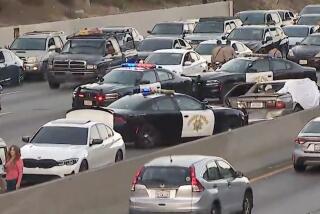Graffiti Project a Victim of Gang Killings
- Share via
Homeboy Industries on Friday closed down its graffiti-removal program in Boyle Heights and East Los Angeles after the shooting deaths of two employees, saying the job had become too dangerous.
Father Gregory Boyle, who founded the organization after the 1992 riots, vowed to continue other job programs his organization offers to people trying to leave street gangs but said the recent violence makes graffiti-cleanup too risky.
“I don’t want to be in the graffiti-removal business any more,” Boyle said. “The guys said they were willing to live with the risk. I told them, ‘But I’m not willing to let you live with the risk.’ ”
The graffiti cleanup effort has been credited with reducing tagging on the streets of Boyle Heights, which police say has the highest concentration of gangs in Los Angeles. The crews also worked in Lincoln Heights, Highland Park and surrounding neighborhoods.
Councilman Antonio Villaraigosa, whose district includes Boyle Heights, said he was “broken-hearted” about the end of the graffiti program.
“I believe in what Father Boyle is trying to do,” he said. But he added that Boyle is “acting with prudence and diligence” in shutting down the program.
“We all have a responsibility to ensure that we are doing everything possible to protect the health and safety of our residents,” Villaraigosa said.
The shootings of the two graffiti-removal workers have shaken the community, though police said they doubt the men were killed because they were cleaning tags from walls.
Miguel Gomez, 34, was killed June 24 by gang members as he painted over graffiti. On Tuesday, Arturo Casas, 25, was shot just a block from Homeboy Industries as he drove to a graffiti-removal assignment in one of the organization’s pickup trucks.
At first, investigators thought Gomez had been shot by gang members angry that he was painting over their gang scrawl, said Det. Rick Peterson of the Los Angeles Police Department.
But it now appears that Gomez, who had been released from prison just three months earlier, was targeted by people from his past, Peterson said.
Casas’ shooting also appears to be related to his ties to gangs, Peterson said.
Boyle said whatever the reason for their shooting deaths, he strongly believes that Gomez and Casas were trying to turn their lives around.
“Arturo Casas was a man who really chose to be different and to redirect his life, and that decision was genuine,” Boyle said. “He’s a guy who showed up every day and was not living a double life.”
Homeboy Industries was created as a way of giving job experience to gang members who, because of felony records, visible tattoos or other reasons, would be hard to immediately place in outside jobs. Over the years, Homeboy has employed people as bakers, silk screeners, landscapers, plumbers and tortilla makers. More than 60 people now work for Homeboy Industries.
The decision to shut down the graffiti-removal program had less to do with the motives for the killings than his feeling that his employees were vulnerable, Boyle said.
Despite police assurances that Homeboy Industries’ work was not the reason the two men were killed, Boyle said there were simply other safer opportunities for people trying to leave their former life. “We did this for three years without incident,” he said. “This simply has changed things.”
Joey Lucero, 26, a former gang member from San Diego who is now an office manager at Homeboy Industries, said while the end of the program was sad, Boyle just thought “it’s not worth it for him to lose people he’s trying to help.”
The priest said he did not see the end of the graffiti-removal program as a defeat. “These have been very stressful days filled with extraordinary heartbreak,” Boyle said. “It’s a hard decision. [Graffiti removal] was a hallmark of our place and, well, another hallmark will take its place.”
Times staff writer Jessica Garrison contributed to this report.
More to Read
Sign up for Essential California
The most important California stories and recommendations in your inbox every morning.
You may occasionally receive promotional content from the Los Angeles Times.














